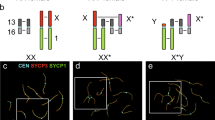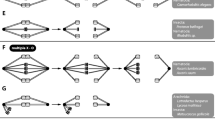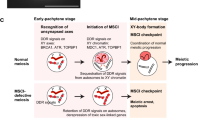Summary
The factors possibly responsible for the occurrence of sexchromatin-negative female cells are reviewed. In such cells, neither of the two X-chromosomes is condensed during interphase; thus the heteropyknosis of one X-chromosome observed in sexchromatinpositive cells is absent.
In somatic cells, the absence of heteropyknosis is not related to the DNA-synthesisperiod and is not correlated with the late replication of one of the X-chromosomes which occurs in all cells, with and without sex chromatin.
The genetic inactivation of one X-chromosome seems to persist in sexchromatin-negative cells. Thus in this respect the objections to the Lyon hypothesis cannot be maintained. Since the genetic inactivity of heterochromatic chromosomes is not due to heteropyknosis, the latter cannot be the cause of their inactivity.
Oocytes and early embryonic cells fall within a special category, in that the genetic inactivation of one of the two X-chromosomes presumably does not occur, also no heteropyknosis of one of the X-chromosomes can be observed.
The formation of a sexchromatin body can be influenced by certain factors such as phase of the cell cycle and cell density. The findings in respect of single-and multi-nucleated cells of Microtus agrestis, here reported, show however that the degree of heteropyknosis of the sex chromosomes within a cell-nucleus is to a large extent fixed and independent of extrinsic factors. It is presumably transmitted through mitosis to the daughter cells.
Zusammenfassung
Die Faktoren, die für das Auftreten Sexchromatin-negativer weiblicher Zellen verantwortlich gemacht werden können, werden zusammenfassend dargestellt. In solchen Zellen ist keines der beiden X-chromosomen während der Interphase stärker kondensiert, d.h., es fehlt die in Sexchromatin-positiven Zellen zu beobachtende Heteropyknose eines X-Chromosoms.
In somatischen Zellen steht des Fehlen der Heteropyknose in keinem Zusammenhang mit der DNS-Synthese-Periode, es ist auch nicht korreliert mit der Spätreplikation eines X-Chromosoms, die in allen Zellen, mit und ohne Sexchromatin, vorhanden ist. Die genetische Inaktivierung eines X-Chromosoms bleibt in Sexchromatin-negativen Zellen offenbar bestehen. Die in dieser Hinsicht gegen die Lyon-Hypothese vorgebrachten Einwände sind nicht aufrechtzuerhalten.. Da die genetische Inaktivität heterochromatischer Chromosomen nicht an die Heteropyknose gebunden ist, kann diese auch nicht die Ursache der Inaktivität sein.
Eine gewisse Sonderstellung nehmen Oocyten und frühembryonale Zellen ein, bei denen die genetische Inaktivierung eines der beiden X-Chromosomen vermutlich nicht stattfindet, und die keine Heteropyknose eines X-Chromosoms erkennen lassen.
Die Ausbildung eines Sexchromatinkörperchens kann durch bestimmte Faktoren, wie Zellcyclusstadium und Zelldichte beeinflußt werden. Die hier vorgelegten eigenen Befunde an ein-und mehrkernigen Zellen von Microtus agrestis ergaben aber, daß der Grad der Heteropyknose der Geschlechtschromosomen innerhalb eines Zellkernes unabhängig von äußeren Faktoren witgehend fixiert ist und bei der Mitose vermutlich auf die Tochterzellen weitergegeben wird.
Similar content being viewed by others
Literatur
Austin, C. R., Amoroso, E. C.: Sex chromatin in early cat embryos. Exp. Cell Res. 13, 419–421 (1957).
Back, F.: Lyon hypothesis and X-linked disease. Lancet 1968 I, 695–696.
Barr, M. L.: The significance of the sex chromatin. Int. Rev. Cytol., 19, 35–95 (1966).
— Bertram, E. G.: A morphologicaldistinction between neurones of the male and female, and the behavior of the nucleolar satellite during accelerated nucleoprotein synthesis. Nature (Lond.) 163, 676–677 (1949).
Bishop, A., Bishop, O. N.: Analysis of tritium-labelled human chromosomes and sex chromatin. Nature (Lond.) 199, 930–932 (1963)
Blanco de del Campo, M. S., Garcia Ramirez, O. E.: Fluctuations of the sex chromatin during the menstrual cycle Acta cytol. (Philad.) 9, 251–256 (1965).
Comings, D. E.: The inactive X-chromosome. Lancet 1966 II, 1137–1138. The duration of replication of the inactive X-chromosome in humans based on the persistence of the heterochromatic sex chromatin body during DNA synthesis. Cytogenetics 6, 20–37 (1967).
—: Sex chromatin nuclear size and the cell cycle. Cytogenetics 6, 120–144 (1967).
Danes, B. S., Bearn, A. G.: Hurler's syndrome: a genetic study of clones in cell culture with particular reference to the Lyon hypothesis. J. exp. Med. 126, 509–522 (1967).
Davidson, R. G., Nitowsky, H. M., Childs, B.: Demonstration of two populations of cells in the human female heterozygous for glucose-6-phosphate dehydrogenase variants. Proc. natl. Acad. Sci. (Wash.) 50, 481–485 (1963).
De Mars, R.: Sex chromatin mass in living cultivated human cells. Science 138, 980–981 (1962).
Epstein, C. J.: Mammalian Oocytes: X chromosome activity. Science 163, 1078–1079 (1969).
Fraccaro, M., Lindsten, J.: Observations on the so called sexchromatin in human somatic cells cultivated in vitro. Exp. Cell Res. 17, 536–539 (1959).
Frasier, S. D., Crudo, F. S., Farell, F. J.: Buccal smears in the newborn female. J. Pediat. 65, 222–225 (1964).
Gilbert, C. W., Mudal, S., Lajtha, L. G., Rowley, J.: Time sequence of human chromosome duplication. Nature (Lond.) 195, 869–873 (1962).
Graham, M. A.: Sex chromatin in cell nuclei of the cat from the early embryo to maturity. Anat. Rec. 119, 469–485 (1954).
Grüneberg, H.: Sex-linked genes in man and the Lyon hypothesis. Ann. hum. Genet. 30, 239–257 (1967).
—: Threshold phenomena versus cell heredity in the manifestation of sexlinked genes in mammals. J. Embryol. exp. Morph. 22, 145–179 (1969).
Grumbach, M. M., Morishima, A., Taylor, J. H.: Human sex chromosome abnormalities in relation to DNA replication and heterochromatization. Proc. nat. Acad. Sci. 49, 581–589 (1963).
Heil, B.: Die Häufigkeit von spätreplizierenden X-Chromosomen und Sexchromatinkörperchen in normalen menschlichen Zellen in vitro. Hum.-Genet. 9, 64–74 (1970).
Hienz, H. A.: Die zellkernmorphologische Geschlechtserkennung in Theorie und Praxis. Heidelberg: A. Hüthig. 1959.
Hösli, P.: Shape and position of the sex chromatin in living human cells. Acta anat. (Basel) 55, 370–392 (1963).
Hsu, L. Y. E., Klinger, H. P., Weiss, J.: Influence of nuclear selection criteria on sex chromatin frequency in oral mucosa cells of newborn females. Cytogenetics 6, 371–382 (1967).
Issa, M., Blank, C. E., Atherton, G. W.: The temporal appearence of sex chromatin and of the late-replicating X chromosome in blastocytes of the domestic rabbit. Cytogenetics 8, 219–237 (1969).
James, J.: Observations on the so called sexchromatin. Z. Zellforsch. 51, 597–616 (1960).
—: Intermitotic transformation of the Barr body in cultured cells of the human female. Z. Zellforsch. 64, 178–188 (1964).
Johnson, R. T., Harris, H.: DNA synthesis and mitosis in fused cells. II. HeLa-chick erythrocyt heterokaryons. J. Cell Sci. 5, 625–644 (1969).
Kinsey, J. D.: X-chromosome replication in early rabbit embryos. Genetics 55, 337–343 (1967).
Klinger, H. P.: The sex chromatin in fetal and maternal portions of the human placenta. Acta anat. (Basel) 30, 371–397 (1957).
—: The fine structure of the sex chromatin body. Exp. Cell Res. 14, 207–211 (1958).
— Davis, J., Goldhuber, P., Ditta, T.: Factors influencing mammalian X chromosome condensation and sex chromatin formation. I. The effect of in vitro cell density on sex chromatin frequency. Cytogenetics 7, 39–57 (1968).
—, Schwarzacher, H. G.: The sex chromatin and heterochromatic bodies in human diploid and polyploid nuclei. J. biophys. biochem. Cytol. 8, 345–364 (1960).
—— Weiss, J.: DNA content and size of sex chromatin positive female nuclei during the cell cycle. Cytogenetics 6, 1–19 (1967).
Levij, I. S.: A three-dimensional interpretation of apparent difference of sex chromatin. Israel J. med. Sci. 3, 783–786 (1967).
Lyon, M. F.: Gene action in the X-chromosome of the mouse (Mus musculus L.). Nature (Lond.) 190, 372 (1961).
—: Sex chromatin and gene action in the mammalian X-chromosome. Amer. J. hum. Genet. 14, 135–148 (1962).
—: Chromosomal and subchromosomal inactivation. Ann. Rev. Genet. 2, 31–52 (1968).
Melander, Y.: Chromosomal behavior during the origin of sex chromatin in the rabbit. Hereditas (Lund) 48, 645–661 (1962).
Miles, C. P.: Morphology and functional relations of sex chromatin in cultured amnion cells. Exp. Cell Res. 20, 324–337 (1960).
Miller, O. J., Warburton, D.: The control of sex chromatin. I. The significance of the distribution of sex chromatin counts in individuals with three or more X-chromosomes. Cytogenetics 7, 58–77 (1968).
Mittwoch, U.: Barr bodies in relation to DNA values and nuclear size in cultured human cells. Cytogenetics 6, 38–50 (1967).
Moore, K. L., Barr, M. L.: Nuclear morphology, according to sex in human tissues. Acta anat. (Basel) 21, 197–208 (1954).
Morishima, A., Grumbach, M. M., Taylor, J. H.: Asynchronous duplication of human chromosomes and the origin of sex chromatin. proc. nat. Acad. Sci. (Wash.) 48, 756–763 (1962).
Ohno, S., Klinger, H. P., Atkin, N. B.: Human oogenesis. Cytogenetics 1, 42–51 (1962).
Park, W. W.: The occurrence of sex chromatin in early human and macaque embryos. J. Anat. (Lond.) 91, 369–373 (1957).
Pera, F.: Struktur und Position der heterochromatischen Chromosomen in Interphasekernen von Microtus agrestis. Z. Zellforsch. 98, 421–436 (1969).
Pera, F.: Über den Wechsel der Ploidie und das Verhalten heteroploider Zellen in vitro. Erg. Anat. Entwickl.-Gesch. (im Druck).
— Schwarzacher, H. G.: Die Verteilung der Chromosomen auf die Tochterzellkerne multipolarer Mitosen in euploiden Gewebekulturen von Microtus agrestis. Chromosoma (Berl.) 26, 337–354 (1969).
— Wolf, U.: DNS-Replikation und Morphologie der X-Chromosomen während der Syntheseperiode bei Microtus agrestis. Chromosoma (Berl.) 22, 378–389 (1967).
Salzmann, J., De Mars, R., Benke, P.: Singe-allele expression at an X-linked hyperuricemia locus in heterozygous human cells. Proc. nat. Acad. Sci. (Wash.) 60, 545–552 (1968).
Schmid, W.: DNA-replication patterns of human chromosomes. Cytogenetics 2, 175–193 (1963).
— Smith, D. W., Theiler, K.: Chromatinmuster in verschiedenen Zelltypen und Lokalisation von Heterochromatin auf Metaphasechromosomen bei Microtus agrestis, Mesocricetus auratus, Cavia cobaya und beim Menschen. Arch. Klaus-Stift. Vererb.-Forsch. 40, 35–49 (1965).
Schnedl, W.: Untersuchungen über das Sexchromatin in menschlichen Fibroblastenkulturen. Acta anat. (Basel) 57, 52–65 (1964).
—: Die DNS-Synthese im Sexchromatin. Cytobiologie 1, 115–120 (1969).
—: Sexchromatin und Kerngröße im Zellzyklus. Kombinierte histophotometrische und autoradiographische Untersuchungen an menschlichen Fibroblastenkulturen. Chromosoma (Berl.) 27, 421–435 (1969).
Schwarzcher, H. G.: Sex chromatin in living human cells. Cytogenetics 2, 117–128 (1963).
—: Kernstruktur und Geschlechtschromatin menschlicher Zellen in vitro im lebenden Zustand und nach Fixierung. Acta anat. (Basel) 57, 91–104 (1964).
Sieger, M., Pera, F., Schwarzacher, H. G.: Genetic inactivity of heterochromatin and heteropycnosis in Microtus agrestis. Chromosoma (Berl.) 29, 349–364 (1970).
Smith, D. W., Marden, P. M., McDonald, M. J., Speckhard, M.: Lower incidence of sex chromatin in buccal smears of newborn females. Pediatrics 30, 707–711 (1962).
Sutter, L. A.: Über das Gechlechtschromatin des Mundhöhlenepithels unter Berücksichtigung von Lebensalter und Menstruationszyklus. Acta anat. (Basel) 43, 204–218 (1961).
Taylor, A. I.: Sex chromatin in the newborn. Lancet 1963 I, 912–914.
Therkelsen, A. J., Lamm, L. U.: Difference in the frequency of sex chromatin positive cells in DNA-synthesizing and non-synthesizing human cells in tissue cultures. Exp. Cell Res. 41, 215–217 (1966).
— Petersen, G. B.: Frequency of sex-chromatin-positive cells in the logarithmic and postlogarithmic growth phases of human cells in tissue cultures. Exp. Cell Res. 28, 588–590 (1962).
Tiepolo, L., Fraccaro, M., Hulten, M., Lindsten, J., Mannini, A., Ming, P., Ming, L.: Timing of sex chromosome replication in somatic and germ-line cells of the mouse and the rat. Cytogenetics 6, 51–66 (1967).
Wegmann, T. G., Smith, D. W.: Lower incidence of sex chromatin in newborn females delivered by cesarean section. Pediatrics 34, 419–421 (1964).
Wolf, U., Flinspach, G., Böhm, R., Ohno, S.: DNS-Reduplikationsmuster bei den Riesen-Geschlechtschromosomen von Microtus agrestis. Chromosoma (Berl.) 16, 609–617 (1965).
Author information
Authors and Affiliations
Additional information
Herrn Prof. Dr. G. Wolf-Heidegger zum 60. Geburtstag in Dankbarkeit und Verehrung gewidmet.
Rights and permissions
About this article
Cite this article
Schwarzacher, H.G., Pera, F. Das Problem der Sexchromatin-negativen Zellen. Z. Anat. Entwickl. Gesch. 132, 18–23 (1970). https://doi.org/10.1007/BF00520950
Received:
Issue Date:
DOI: https://doi.org/10.1007/BF00520950




